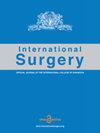致编辑:发展中国家的人道主义心脏外科护理:在实现可持续全球健康中的作用
IF 0.2
4区 医学
Q4 SURGERY
引用次数: 0
摘要
在最不发达国家的城市和农村社区,儿童和成人心血管疾病(CVD)呈上升趋势。就撒哈拉以南非洲而言,心血管疾病现在是过早死亡的主要原因,卫生基础设施差,缺乏熟练的心脏保健专业人员。在心脏外科专业的成员之间有很多讨论,如何最好地解决后者在这些国家。此前,我们曾提议采取几项行动,旨在实施人道主义项目,支持世界各地卫生系统中负担不起的患者,这将是一种前进的方式。然而,另一方面,欧洲心胸外科协会及其国际委员会不认为向发展中国家派遣团队是最好的解决方案。他们的理由是,团队合作在心脏手术中尤为重要,因为最薄弱的环节可能决定手术的最终结果。以此为出发点,我们探索了在当地中心实施培训的方式,部分资金来自慈善捐赠和公私合作模式。国际心脏之眼基金会;www.cardiaceye.com)小组对肯尼亚沿海城市蒙巴萨进行了试探性访问,探讨与政府代表和卫生部长以及当地医院医生和行政人员的联系。在这次访问中,基金评估和审查了当地的经验和知识水平以及现有设备。提出了一项项目建议,旨在根据需要,通过合作培训专家,扩大在当地向负担不起费用的患者提供心脏手术服务的范围。一个心血管外科小组由一名心脏病专家、一名外科医生、一名麻醉师、一名灌注师、一名清洁护士、一名重症监护护士、一名呼吸治疗师(或两者都有)组成,必要时还有一名病房护士。本文章由计算机程序翻译,如有差异,请以英文原文为准。
To the Editor: Humanitarian Cardiac Surgery Care for Developing Countries: Role in Achieving Sustainable Global Health
Cardiovascular disease (CVD) in children and adults in least developed countries is on the rise in both urban and rural communities. In the case of sub-Saharan Africa, CVD is now a leading cause of premature deaths, with poor health infrastructure and shortage of skilled cardiac healthcare professionals. There is much discussion among members of the cardiac surgical specialty as to how best to address the latter in such countries. Previously, we have proposed that several actions aimed at implementing humanitarian programs to support nonaffording patients in health systems around the world, would be a forward way. However, the European Association of Cardiothoracic Surgery and its International Committee, on the other hand, does not believe that the best solution is achieved by sending teams to the developing world. Their point of justification is that teamwork is particularly important in cardiac surgery, where the weakest link can determine the ultimate outcomes of surgery. Using this as our starting point, we explored ways of implementing training in local centers partly funded through charitable donations and a public private partnership model. The CardiacEye International Foundation (CEIF; www.cardiaceye.com) team made an exploratory visit to the coastal city of Mombasa in Kenya, to explore contacts with government representatives and health ministers and local hospital doctors and administrators. During this visit, CEIF assessed and examined the levels of local experience and knowledge and the available equipment. A project proposal was put forward aiming to expand scope for provision of cardiac surgery services locally to nonaffording patients through collaborative training of specialists depending on the needs. A cardiovascular surgical team was put together made up of a cardiologist, a surgeon, an anesthetist, a perfusionist, a scrub nurse, an intensive care nurse, a respiratory therapist (or both), and a ward nurse where necessary.
求助全文
通过发布文献求助,成功后即可免费获取论文全文。
去求助
来源期刊

International surgery
医学-外科
CiteScore
0.30
自引率
0.00%
发文量
10
审稿时长
6-12 weeks
期刊介绍:
International Surgery is the Official Journal of the International College of Surgeons. International Surgery has been published since 1938 and has an important position in the global scientific and medical publishing field.
The Journal publishes only open access manuscripts. Advantages and benefits of open access publishing in International Surgery include:
-worldwide internet transmission
-prompt peer reviews
-timely publishing following peer review approved manuscripts
-even more timely worldwide transmissions of unedited peer review approved manuscripts (“online first”) prior to having copy edited manuscripts formally published.
Non-approved peer reviewed manuscript authors have the opportunity to update and improve manuscripts prior to again submitting for peer review.
 求助内容:
求助内容: 应助结果提醒方式:
应助结果提醒方式:


